This website has been archived from TrainWeb.org/gyra to TrainWeb.US/gyra.
This website has been archived from TrainWeb.org/gyra to TrainWeb.US/gyra.
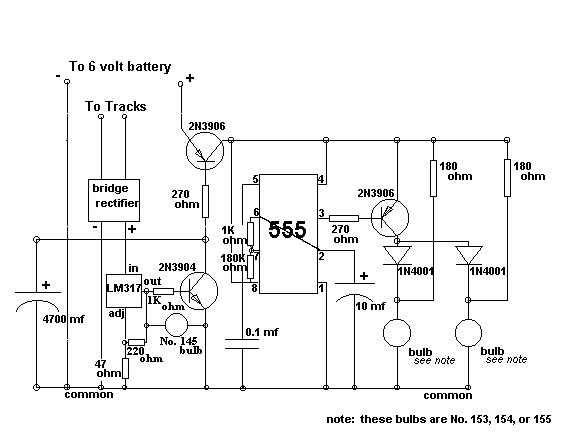
Parts List: 1-(diode bridge)/1-(LM317 regulator)/(1-(NE555 timer)/2-(2N3906 transistors)/
1-(2N3904 transistor)/2-(1N4001 diodes)/1-(* 4700 mf capacitor)/1-(10 mf capacitor)/1-(0.1 mf
capacitor)/2-(180 ohm resistors)/2-(270 ohm resistors)/1-(220 ohm resistor)/1-(47 ohm resistor)/
2-(1K ohm resistors)/1-(180K ohm resistor or combination of resistors in series to give 1 flash/sec)/
6-(3 amp diodes - for diode banks)
* capacitor functions to prevent erratic operation of the timer by keeping the 2N3904 transistor
turned on during spikes of track voltage loss to this transistor. Any value of capacitance which accomplishes this
can be used.
This circuit produces a simulation of the 20585 Gyralite, using a dim to bright circuit.
The circuit is designed to flash the dual lights on briefly to simulate the flash effect seen
by the observer. The circuit incorporates a square wave that produces a "strobe-like" flash.

This circuit could have been built into a locomotive dummy and pushed from behind, but I have found that for overall stability in preventing derailments, that pulling seems to be the favored option.
This circuit is designed to be run on a filtered DC source. The circuit in this
particular case was designed to light the bulbs while the locomotive is stopped. The
flasher for the circuit uses 4 AAA cells mounted in the adjacent boxcar. The lights are
illuminated by the input of voltage to the track. A 1.5 volt (Model Power No. 145) bulb
provides interior lighting to the locomotive.

The 2 bulbs which are used in the flasher are Model Power 153, 154, or 155 bulbs made clear with nail polish remover.
The roof is removed from the main shell.
The headlight-number board insert is removed.
The number board insert parts are carefully broken off of the headlight mid-section.
The louvers are cut off flush with headlight.
The headlight holes in the roof are now bored out, if necessary with 5/64" bit - very
carefully.
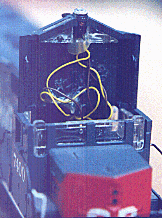
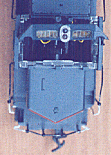
A "Details West" HL-148 (flush mount Twin Gyralite) is used for authenticity. It may
be painted if desired. This fixture is carefully bored out to accomodate the bulb tips
which simulates the prototype's lenses. It is glued between the number boards (the
hinges are on the right as one faces the locomotive). Louvers can be made up or
possibly salvaged from above and secured (glued) to the HL-148, if desired.
The 2 number board parts are secured to the roof with glue.
The bulbs are secured with glue. (keeping in mind replacement of the bulbs).
The shell of the Athearn HO SD45 locomotive is removed. The tab of the windshield is filed, if necessary, for assembly.
The interior lighting assembly is totally removed.
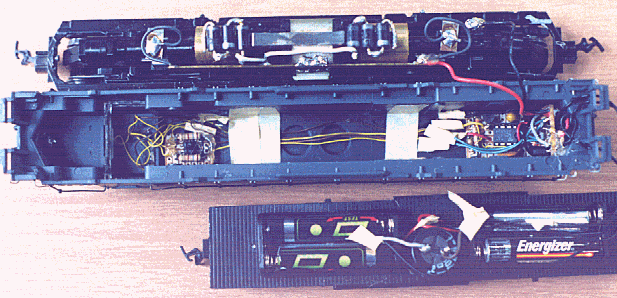
The contact bar along the top of the motor which makes contact with the trucks is
removed. A piece of 0.032" brass 1/4" wide is cut to a length which will enable wires on
the side towards the center of the locomotive to be soldered to the ends of this brass and
to the trucks. The brass is sanded in preparation for soldering to the side of the motor
which is opposite to the closed "C" part of the truck contacts. The brass strip is soldered
to the motor using low heat. One can remove the parts from the motor casing to assure
no damage to parts from heat. A wire is soldered to the truck contact of each truck and to
the inside edge of the brass strip. The wire has a loop in it to allow the trucks to pivot. A
second wire is soldered to the inside of the rear portion of the brass strip at the edge. A
hole is drilled horizontally into the part of the base that supports the rear truck. It is
drilled (PC drill) near the edge so that no interference will occur to the pivoting action of
the trucks. A piece of 18 guage copper wire is forced through the hole and looped
around the base part supporting the rear truck. The loop is clamped tightly. A wire is
soldered to this loop and directed rearward.
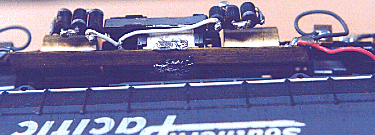
Voltage dropping diode banks are made up as shown in the photo. Each diode (3 amp) in
each bank is in series to drop voltage to the motor. Each bank (of the 2) functions to
drop voltage in the polarity of the voltage applied to the track.
The former contact strip that was removed at the beginning of the disassembly is cut so
the terminal ends of each bank can be soldered to the edges of this strip. A wire is
soldered to each of the other ends of each diode bank and these are in turn soldered to
the inside of the brass strip.
This top strip is then soldered to the contact strip which is in contact with the
motor's brush spring for electrical connection assurance.
The 2 diode banks are glued to the trimmed contact strip and clearance is checked
between the flywheels and the trimmed strip.
It is important when locating the brass strip to make sure that it will not interfere
with flywheel rotation or the replacement of the shell of the locomotive.
The circuit was made up of 3 circuit boards. The circuit board was cut to
accomodate the placement on the underside of the roof of the shell.
The first board or voltage regulator board was mounted at right angles to the roof in this instance. A LM317LZ 100ma adjustable voltage regulator was used. This regulator is in the TO92 case which makes for compact mounting. The tab can be removed from the convential LM317 T220 case for compact mounting - if this type is used. The voltage regulator supplies voltage for the No. 145 Model Power bulb to light the interior of the cab as well as providing forward bias to turn of the circuit.
The second or main circuit board is located to the rear of the shell as shown.
The required resistance of the timing circuit was made up of 3 resistors in series.
(100k+47k+33k) These are mounted to the circuit board in a compact fashion and
connected between pins 8 and 7 of the 555 IC. A socket is used to mount the 555 IC.
The third board is mounted in a non-interferring location on the underside of the roof
in the front of the shell. Mounted on this board are 2 diodes together with the 2 resistors
supplying current to the flashing bulbs.
Hot glue is used to mount the board, keeping in mind that they might have to be
removed if service is necessary.
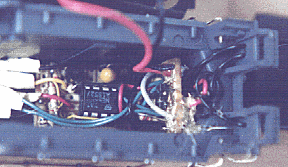
At the rear of the locomotive shell, holes are drilled (PC bit) to simulate air hoses connecting to the box car carrying the 6 volt supply for the circuit. A 4700 mf capacitor was mounted (glued) to the floor of the trailing boxcar.
Wiring is chosen for compactness and flexibility. Connections are soldered and taped and secured, if necessary to prevent interference with the mechanical mechanism of the locomotive. A drop of hot glue is used to reinforce the wire junctions which connect the chassis section to the circuit board.
This circuit can be revised by:
1) using metal wheels on the boxcar for electical pickup ---- all electronics could be
in boxcar
2) using AA bateries (if necessary) -or rechargeable batteries
3) interior locomotive cab bulb could be run off battery